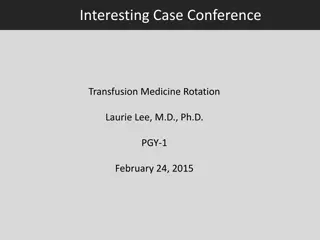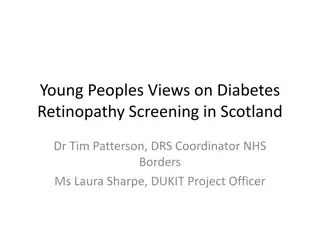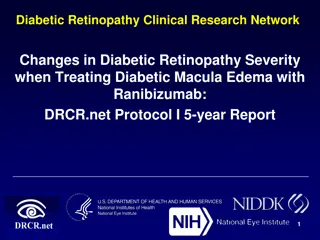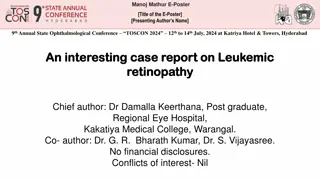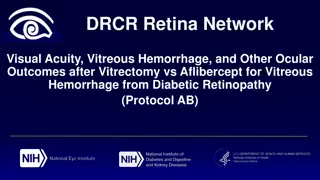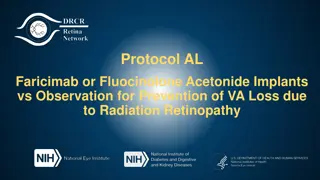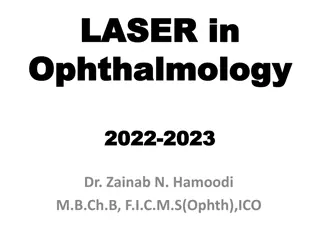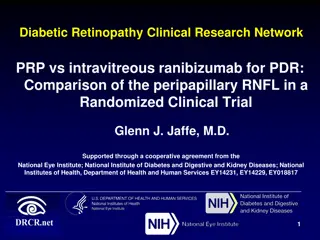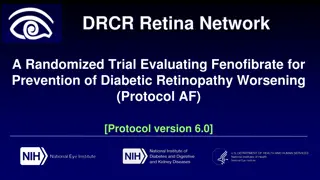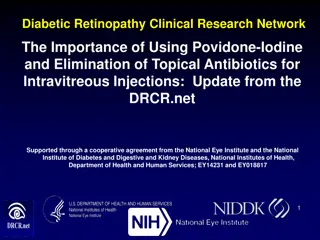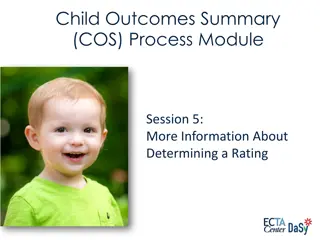Retinopathy Of Prematurity
Dr. Sarah Farshadfar dives into the complex topic of Retinopathy of Prematurity, providing valuable insights and information on this condition affecting premature infants. Her expertise sheds light on diagnosis, treatment options, and the challenges faced by healthcare professionals in managing this condition. A must-read for those seeking in-depth knowledge on Retinopathy of Prematurity.
Download Presentation

Please find below an Image/Link to download the presentation.
The content on the website is provided AS IS for your information and personal use only. It may not be sold, licensed, or shared on other websites without obtaining consent from the author.If you encounter any issues during the download, it is possible that the publisher has removed the file from their server.
You are allowed to download the files provided on this website for personal or commercial use, subject to the condition that they are used lawfully. All files are the property of their respective owners.
The content on the website is provided AS IS for your information and personal use only. It may not be sold, licensed, or shared on other websites without obtaining consent from the author.
E N D
Presentation Transcript
Retinopathy Of Prematurity Dr Sarah farshadfar
ROP Definition - Vasoproliferative disorder of the retina which occurs principally in the preterm infant. Specifically, occurs in the incompletely vascularized retina. A vascular problem.
ROP Originally described as retrolental fibroplasia in the early 1940s, owing to (overly?) aggressive oxygen use. Nearly disappeared between 1954-1970, when oxygen use severely restricted. But now, has returned, secondary to improved neonatal practice of VLBW infants. Est. 400 infants blinded each yr; 4300 with serious retinal scars.
ROP Incidence: MHMC NICU 1997-2001 BW(g) %ROP (all) GA (wks) %ROP (all) 0-500 11 501-750 45 751-1000 42 1001-1250 12 1251-1500 4 1501-1750 0.8 1751-2000 0.4 >2000 0 0-23 24-25 26-27 28-29 30-31 32-33 34-35 >35 22 45 45 20 6 1 0.2 0
ROP - Pathogenesis ROP can occur when the retinal vessels have not yet completed their centrifugal growth from the optic disc to the ora serratia. Primitive endothelial cells ( spindle cells ) form cords that canulize into capillaries and further differentiate into arterioles and venules.
ROP - Pathogenesis 16 weeks of gestation - primitive spindle cells gradually grow out over the surface of the retina. 29 weeks -reached ora serrata. At this time these spindle cells start to form blood vessels. The vessels reach the anterior edge of the retina and stop their progression at about the time of birth.
ROP - Pathogenesis During vasculogenesis if the retina is exposed to toxic substance or other insult normal (e.g., hypoxia, increased oxygen, shock, preterm delivery) vasculogenesis is interrupted. A sharp demarcation line appears between inner vascular and outer avascular zone. After the injury, vessel growth can resume normally (no ROP), or (for unknown reasons), the primitive vessels pile-up within the retina, growing without forward progress and forming a ridge of tissue.
ROP - Pathogenesis The retina anterior to this line does not have an adequate oxygen supply, and probably exudes chemical signals that stimulate new vessel growth. As more new vessels grow in response to the chemical signals, they form arterio-venous shunts at the location of the barrier on the surface of the retina. This shunt gradually enlarges, becoming thicker and more elevated. The new vessels are accompanied by fibroblasts, which produce fibrous scar tissue. When this scar tissue contracts, it pulls on the retina and produces a traction retinal detachment.
ROP - Pathogenesis Until completely vascularized, vasculogenesis is highly vulnerable to any sort of insult or stress, including medications, high levels of oxygen, and variations in light and temperature.
ROP - Risk Factors Gestational age and low birth weight Supplemental oxygen Vitamin E deficiency Race (increased in Caucasians) Surfactant Light levels Multiple births Transport after delivery
ROP - Risk Factors OTHER Indomethacin Elevated blood carbon dioxide levels Anemia Blood transfusions IVH RDS Chronic hypoxia in utero Multiple spells of apnea or bradycardia Mechanical ventilation Seizures
ROP - Classification 1984 and 1987 International Classification of ROP: 3 Zones (location) Clock hours (extent) Stages 1 through 5 Plus Disease
ROP - Classification 12 12 I I 3 II III 3 9 9 I III II Ora serrata Macula 6 6 Optic disc Left eye Right eye
ROP - Classification ROP - Classification Stage 1. Demarcation line between the normal retina (left) and the non-vascularized retina (right). Stage 1 Stage 1 - demarcation line - demarcation line between the normal retina between the normal retina nearer the optic nerve (on nearer the optic nerve (on the left), and the non- the left), and the non- vascularized vascularized retina (on the right). right). retina (on the Multiple small abnormally Multiple small abnormally branching vessels can branching vessels can sometimes be seen leading sometimes be seen leading into the demarcation line. into the demarcation line. demarcation line. Multiple small abnormally braching vessels can sometimes be seen leading into the
ROP - Classification Stage 2 - ridge (R) of scar tissue and new vessels in place of the demarcation line. The white line now has width and height, and occupies some volume. Small tufts of new vessels ("popcorn vessels") may appear posterior to the ridge (arrowhead).
ROP - Classification Stage 3 - Increased size of the vascular ridge (between the arrowheads), with growth of fibrovascular tissue on the ridge and extending out into the vitreous. Fibrous scar tissue is beginning to form in this stage, with attachments between the vitreous gel and the ridge.
ROP - Classification Stage 4 - Partial retinal detachment. Stage 4A - detachment does not include the macula, and the vision may be good. In Stage 4B - macula is detached, and the visual potential is markedly decreased. Stage 5 - Complete retinal detachment.
ROP - Classification Plus disease - engorgement and tortuosity of the blood vessels near the optic nerve. Also includes growth and dilation of abnormal blood vessels on the surface of the iris, rigidity of the iris, and vitreous haze (exudate along the retinal vessels). Can accompany any stage, but indicates greater likelihood of progression to Stage 3 (or greater).
ROP - Classification Rush Disease: Plus disease + Zone I ROP Progression occuring in days, rather than weeks.
Pre-threshold ROP Increased likelihood of progression to retinal detachment if left untreated> Zone I, any stage Zone II, plus disease with stage 1, 2
Threshold ROP ROP with 50% likelihood of progression to retinal detachement if left untreated> Stage 3 with 5 continuous clock hours or 8 cumulative clock hours with plus disease
ROP - Management PREVENTION - Prevent preterm labor. (Optimal) minimum use of oxygen. Prevention of complications.
ROP - Management Screening: In our NICU, all infants <34 wks gestational age AND <1800 g birthweight are screened between 4-6 weeks of age.
ROP - Management CRYOTHERAPY For threshold ROP (stage 3 in at least 5 clock hours with plus disease) Freezing the sclera with cold probe. Multiple applications are done to the entire avascular area anterior to the neovascular ridge. Treatment of the ridge itself is avoided, since the ridge tends to bleed and cause vitreous hemorrhage if frozen. Procedure is painful and done under general anesthesia. Complications: anesthesia problems; eyelid and conjunctivae edema
ROP - Management LASER PHOTOCOAGULATION Laser treatment for ROP is similar to cryotherapy. The laser spot size is smaller than a spot of cryotherapy. Usually 600- 1000 spots of laser as compared to 30-50 spots of cryotherapy needed. Laser is a direct treatment of the retina and its underlying tissue instead of the entire thickness of the eye wall like in cryotherapy. Most ophthalmologists treating ROP are now using laser.
ROP - Management SCLERAL BUCKLE For shallow retinal detachment - placing a silicone band around the equator of the eye to relieves the traction of the vitreous gel. VITRECTOMY For complete retinal detachment -several small incisions into the eye with removal and replacement of the vitreous gel with a saline solution. After the vitreous has been removed, the scar tissue on the retina can be peeled or cut away, allowing the retina to relax and lay back down against the eye wall and to re-attached. The success rate ranges from 25% to 50% of patients undergoing surgery. The functional success rate is significantly lower.
ROP - Complications RETINAL DRAGGING AND FOLDS - Neovascular tissue may heal, but a high risk that it will contract and form a scar ( cicatrix ) that pulls and distorts the retina. The traction may drag the retina over the inside wall of the eye. May result in markedly decreased vision.
ROP - Complications Dragging - yellow/white optic nerve head in the center. The retinal vessels coming from the optic nerve are dragged in the direction of the arrow by scar tissue (out of picture on the right side). The macula, which should be off the left edge of this photograph, is visible as a subtle dark area about one disc diameter to the left of the disc.
Clinical Course Most commonly, onset in Zone 2, slower progression; partial cicatrix; if onset in Zone 3, good prognosis for full recovery. May take up to one year to stabilize, usually outcome apparent by 3 months of age. Mild ROP (Stage 1 or 2 without plus) and heals without a residual cicatrix (retinal scar)> may have higher incidence of myopia, strabismus, amblyopia Threshold ROP with residual cicatrix> severe myopia, strabismus, amblyopia, retinal detachments as adults





